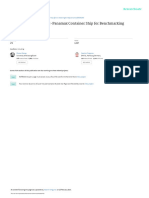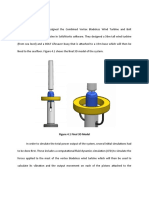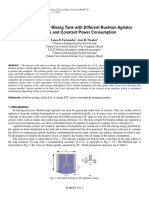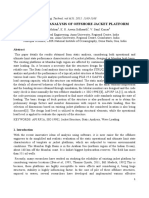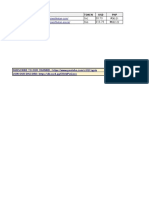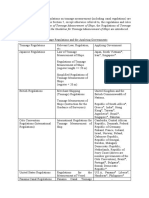Ijett V63P217
Ijett V63P217
Uploaded by
Mikhail Roy Dela CruzCopyright:
Available Formats
Ijett V63P217
Ijett V63P217
Uploaded by
Mikhail Roy Dela CruzOriginal Description:
Original Title
Copyright
Available Formats
Share this document
Did you find this document useful?
Is this content inappropriate?
Copyright:
Available Formats
Ijett V63P217
Ijett V63P217
Uploaded by
Mikhail Roy Dela CruzCopyright:
Available Formats
International Journal of Engineering Trends and Technology (IJETT) - Volume 63 Issue 2 - September 2018
Predicting Main Dimensions of Tug Boats
Basing on Bollard Pull
Stephen Chidozie Duru1, Bawo Dominic Dumka 2.
1
Head, Department of Marine Engineering, Niger Delta University, Amassoma, Bayelsa State, Nigeria.
2
Department Head, Hse – Agip Energy and Natural Resources Ltd, Port Harcourt, Nigeria
Abstract
The pull force a tugboat can exact when tied to Bollard pull bp is expressed by various authorities
an immovable pie bollard is termed the bollard pull, namely [1], [2], [3], [4] show that
this is the maximum pull force she is designed to
exact on her towing work. This force depends on the bp = TT(1-t) - - - - - - - - - - - - - - - - - - (1)
size dimensions, hull shape and design of her TT = f(Do,ηpp,PD) - - - - - - - - - - - - - - -(2)
propulsion machinery. This work is a correlation
analysis between the main dimension variables and Where, ηpp = ηO/ ηi - - - - - - - - - - - -(3)
𝐵
bollard pull is carried out to obtain useful formulas t = t1( , CB) + t2(Hull form) + t3(Do/L)- -(4)
𝐿
for the design of future tug boats basing on optimum Where,
bollard pull. This analysis is based on a collation of TT = propeller Bollard thrust
world existing tug boat parameters shown in the t = Thrust deduction factor
paper. An appraisal example computation is also Do = propeller nozzle diameter
presented to show the method and validity of the ηpp = propeller pump effiency
derived formulas.. PD = Delivered power (kw)
ηO =propeller open water efficiency
Keywords — Tugboat, bollard pull, regression, ηi = propeller ideal efficiency
formulas, main dimensions. B = breadth of the tugboat at midships
I. INTRODUCTION CB = block coefficient of tugboat
L = length of the tugboat
The bollard pull is the force a tug boat require to pull t1, t2, t3, functions of thrust deduction fraction.
the ship or other marine equipment she is towing. It These are well known.
is classified into maximum bollard pull bpmax, steady In this work, however, the correlation analysis is
bollard pull bps and sustained bollard pull bp, on the B, D, T, P/L, P/B, P/D, LB, DT, P/T, LBD,
corresponding to force of the propulsion machinery LBT, P, and √L/B2 as independent variable and bp as
running at maximum (for one minute) , nominal (five independent variable.
minutes), and 78 to 80 percent of nominal power of Where:
the main engine of the tug boat respectively. P = Main engine Power (hp)
Measurement of the bollard pull is done by tethering D = Depth
the tug boat from her towing hook to a force T = Design draft
measuring instrument and to the pier side bollard So far the correlation analysis of the main
before the running of the propulsive machinery under dimensions and the bollard pull bp of tug boats have
calm sea condition see fig 1 below, not been investigated for the purpose of determination
of main dimensions of projected tug boat. The result
of this analysis will aid the prediction of main
dimensions of projected tug boats at early design
stage. This will also help in the purchase or hire of
tug boats for tow or push contracts as the main
dimensions of the tug can be estimated knowing the
total resistance of the towed vessels.
II. MATERIAL AND METHOD
The data shown in Table 1 is a short part of 365
tug boat particulars collected (the sample sizes are
shown in Table 2) for each of the regression analysis.
These data are obtained from the internet adverts of
various companies such as in [5], [6],[7], and others.
FIG 1 Bollard test arrangement
ISSN: 2231 - 5381 http://www.ijettjournal.org Page 94
International Journal of Engineering Trends and Technology (IJETT) - Volume 63 Issue 2 - September 2018
The mathematical model for regression formulas effectively with the mean expected value of L =
fitted to the data were linear and none linear function. 28.08m, B = 8.58m, D = 3.69m T = 3.14m, and P
These are functions of these types = 2211hp
Linear, Y = mx + c . . . . . . . . . . . . . . . . .1
c IV. CONCLUSIONS
Power, Y =mX . . . . . . . . . . . . . . . . . . ..2
Exponential,Y = m ln(X) + c . . . . . . . . . . 3 Bollard pull is the major important parameter in the
Polynomial Y=aXn+ aXn-1+..+ aX1+c…..4 design and operation criteria of tug boats propulsion
Where Y a main dimension function and, system. This paper focuses on the determination of
X is the bollard pull bp of the tugboats the dimensional parameters length L, breadth B,
m, c, and n are constants determined by the depth D, Draft T in meters and power P in horse
regression analysis. power of the tug as a function of the main bollard pull
These are well known mathematical procedures bp in metric tons. The necessary formulas for
according to reference[8], and others. The Microsoft carrying out this task are derived by regression
EXCEL add in software has these program for these analysis from data collated from 116 world existing
procedures and these are used for the regression tug boats. The thirteen formulas derived and shown
analysis in this work. have regression coefficient R2 greater than 0.8. This
Numerous regression correlation were made formulation is very important for the prediction of the
between different formulated tug parametric variables optimum main particulars of the prospective or
and the bollard pull but only those reliable formulas projected tug boat needed to tow other marine
2 equipment (ships, barges, rigs, etc) as shown in the
with correlation coefficient R greater than 0.8 are
selected and published in this paper in fig 2 to fig 14. example stated in this paper. The formulas can also be
Table 2 show the summarized formulas of the used in a computer program for the design of tug
regression analysis where the number of data points N boats.
2 REFERENCES
and the regression coefficients R are also shown.
Table 3 and 4 show an example of the Microsoft [1] Dr Paul Mertes, Hans, J. H.,“Aspects of the Design Procedure
EXCEL spread-sheet method for using these formulas for Propellers Providing Maximum Bollard Pull”
to calculate the main dimensions of tug boat for a International Tug Salvage Convention, Singapore 2008.
particular bollard pull described below. [2] Mohamed Ashraf Ahmed El Zaaliket al, “Theoretical and
Experimental Measurement of Bollard pull with emphasis on
Propellar diameter” International Journal of Multidisciplinery
III. RESULT AND DISCUSSION and current Research Vol 3 2015.
[3] P.Zahalka , “Bollard Pull” Verein Hanseatisher
The resulting formulas from this work are shown Transportversicherer GL, Germany 2010.
[4] Jaroslaw Artyszuk,” Types and Power of Habour Tugs – The
in diagrams (fig 2 to 14) and table 2. If, for example, Latest Trends”, Prace Naukowe Politechniki, Warsaw, April,
the required sustained bollard pull for a tow is 2013
calculated to be 28mt. What will be the main [5] Marintimesale Inc, “Tudboats for Sale”,www.
dimension and power of the tug for the tow? Table 3 Maritimesale.com (2016) .
show the formulas entered in EXCEL work-sheet as [6] Damen Trading and chartering, “Damen Stan Tugs for sale”,
www.damen.com (2016).
Eq(1), Eq(2) etc for the computation of each of the [7] Marcon International Inc, “ Vessels sales”,
main dimensions. Appropriate combinations of these www.marcon.com(2016)
formulas as shown in some cases are necessary to [8] Douglas C. Montgomery, George C. Runger(2002) “Applied
compute a particular dimension of the projected tug Statistics and Probability for Engineers”, John Wiley and
Sons, Inc, USA Pp 372 – 467. 2002
boat. Table 4 show the result of dimensions of tugs
that is required to carry out the towing work
Table 1 A collection of the principal dimension of modern Tugboat including bollard pull bp
NAME CLASS BUILLT LAO(m) B(m) D(m) T(m) bp(mt) ME(hp)
140904 VW TURKEYBV 2016 14.8 5.9 3 2.15 19 1660
140113 VW SPAIN 2011 16 5.5 2.8 2.15 12.5 780
151118 VN ITALY 1986 19 5.37 2.75 2.28 2 577
ISTBUL
130718-VN RINA 2011 19.95 7 3.2 2.2 15 1200
BEN FOSS 1980 23.71 8.00 3.34 2.95 26.4 1700
141057 vw hollandBV 2012 24.07 12.97 4 3.8 53.4 3820
121063-VO SPAIN RINA 1982 25 8.4 4.36 4.2 32 2030
160524-VW SPAIN 1968 25.86 6.4 3.05 3 12 825
151228 VW HOLLAND 2007 26 11.5 3.5 2.25 33 2400
ISSN: 2231 - 5381 http://www.ijettjournal.org Page 95
[Type text] Page 95
International Journal of Engineering Trends and Technology (IJETT) - Volume 63 Issue 2 - September 2018
BV
131028-vo holland bv 2005 26.09 7.94 4.05 3.75 50.7 3500
ARI CRUZ -
SINUK USABS 1995 26.15 8.69 3.05 2.51 11.34 1248
ES
TAURUSINDO CHINA/NKK 1997 26.45 7.96 3.47 3.19 15 1240
151103VW USABS 1982 27.43 9.75 3.41 2.59 23.5 2110
OLIKTOK 27.89 8.17 4.2 3.93 25 2100
9777-tg-om SINGAPORE 1995 28.4 6.5 4.11 3.47 39.05 2800
8710-TG-OM ITALI RINA 1985 28.55 6.56 3.82 3.14 8.7 1520
11326-TG-OM SingporeABS 2006 29 9 4.25 3.5 40 3200
11326-TG-OM ABS 29.1 9 4.25 3.5 30 2400
11346-TG-OM FRANCE GL 1976 29.2 8.5 4.15 3.5 30 1500
12592-TG-OM RUSSIA 1988 29.3 8.3 4.3 3.4 16 1604
CONTELLATION NS 2009 30.22 9 4.38 3.68 30 2400
Island Brave USA ABS 30.99 11.00 5.59 4.60 70 5364
11077-TG-OM BatamIn LR 2005 31 9 4.5 3.5 40 3000
11153-OT-OM SPAIN 2002 31.21 8.41 4.51 4 22.9 1716
T W Ocean 15 USA ABS 1998 31.52 11.28 5.49 4.27 53.8 3900
140821-VO BV 2014 31.65 9.14 4.2 3.65 40 3200
150909 VO USA ABS 2003 31.70 10.97 4.88 4.11 48.58 4200
TITO N
SETTIMO LR 2012 31.99 11.6 5.81 5.36 73 5364
ASD TYR USA ABS 32.00 11.58 5.94 5.36 83.45 6834
13082 TG-OM USA ABS 1999 32.00 10.36 5.03 4.88 62.6 4400
12985 TG OM USA ABS 2012 32.00 11.58 5.38 5.23 60.78 4720
11163-TG-OM turkishBV 32.5 11.7 5.6 4.3 65 5632
130643-VO CHINA ASD 2009 33 10 4.5 4.1 50 4000
141120 VO INDONESIA 1982 33.52 7.92 3.2 2.4 12 1273
CHEV
RICHMOND CHINA 2013 33.98 10 4.5 3.4 50 4000
Table 1. Continued
NAME CLASS BUILT LAO(m) B(m) D(m) T(m) bp(mt) ME(hp)
9547TGOM 2016 34.4 12.82 5.75 5.36 70 6303
9835-TG-OM CHina BV 2014 34.5 9.5 4.6 3.65 40 3200
5922-TG-OM MALAY BV 2016 35 11.5 5.62 4.8 62 5150
12885-TG-OM china BV 2014 36 10.97 5 4.1 40 3200
140413-VO china BV 2014 36 10.97 5 4.1 40 3200
120322-VW 36.02 10.6 4.8 3.6 64 5200
ocean Tower CHINA BV 2009 36.1 10.6 4.9 4 40 3200
ESCORT EAGLE LAUSABS 1970 36.58 9.45 4.54 4.11 37.5 3000
11321-TG-OM KOREA 2012 36.9 10 4.5 3.4 59.464 4500
11143 TUG OM 2007 37 10.6 4.95 4 40.85 3200
11275-TG-OM AFRCA/IRE 1978 37.3 10.84 4.9 4.3 40.6 3500
141137-VA LRDAMEN 1998 37.5 9.25 4.9 3.4 69 5000
ISSN: 2231 - 5381 http://www.ijettjournal.org Page 96
International Journal of Engineering Trends and Technology (IJETT) - Volume 63 Issue 2 - September 2018
CCS CSA
SUIATTIEUS CSM 2012 37.7 10.4 4.8 3.65 65 5200
AHT LRCHINA 37.99 11.00 5.00 3.81 60 4960
Liberty CHINA 2014 50 15.5 7.7 5.5 105 8400
HERCULES CHINABV 2012 58.7 14.6 5.5 4.75 66 4890
ASTERI KEPPEL 2004 60 16 6 5 78.3 6000
150336 VA SINGAPORE 2000 60 13.8 6.8 5.6 124 8000
GERMANY
9397-TG-OM ABS 1982 64.5 13.82 6.9 5.91 110 8160
140929 US ABS 2015 66.5 16 6.5 5.12 80 6400
9397-TG-OM 26.15 7.95 4.05 3.45 38 2720
140929-VA DAMEN 1999 26.15 7.95 4.05 3.45 38 2720
M MORAN 2012 36.6 10.5 4.6 3.3 51 4800
Robust SINGAPORE 2013 81 16.8 7.5 6.4 120 7000
OCEAN Wrestler SINGAPORE 2013 81 16.8 7.5 6.4 120 7000
150632 AUTR 2013 91 22 9.6 8 240 21456
STAN2608 DAMEN 26.15 7.95 4.05 3.45 38 5440
Table 2 Tugboat design formulas as a function of bollard pull(x = bp) in metric tonnes.
N R2 Formula Eq. no
116 0.900 B = -2E-04x2 + 0.0912x + 5.78 - - - - - - - - - - - - - - - - Eq1
83 0.898 D = -7E-05x2 + 0.046x + 2.7135 - - - - - - - - - - - - - - - Eq2
60 0.801 T = -6E-05x2 + 0.0379x + 2.2631- - - - - - - - - - - - - - - Eq3
48 0.897 P/L = 0.0002x3- 0.0105x2 + 1.9129x + 27.443 - - - - - Eq4
60 0.858 P/B = 0.0003x3 – 0.0928x2 + 11.765x - - - - - - - - - - - Eq5
60 0.916 P/D = 0.0006x3 – 0.2093x2 + 25.759x - - - - - - - - - - - Eq6
116 0.906 LB = 0.0102x2 + 5.4694x + 50 - - - - - - - - - - - - - - - - Eq7
66 0.820 DT = 0.0005x2 + 0.4277x - - - - - - - - - - - - - - - - - - - Eq8
60 0.836 P/T = 0.0007x3 – 0.2549x2 + 31.339x - - - - - - - - - - - Eq9
60 0.882 LBD = 0.2457x2 + 22.939x - - - - - - - - - - - - - - - - - - - Eq10D
60 0.879 LBT = 0.1953x2 + 23.382x - - - - - - - - - - - - - - - - - - Eq10T
116 0.967 P = 0.0562x2 + 75.309x - - - - - - - - - - - - - - - - - - - - Eq11
116 0.818 (√L)/ B2 = 0.3725x-0.483 - - - - - - - - - - - - - - - - - - - - - Eq12
48 0.896 P/L = 0.0002x3- 0.0105x2+1.9129x+27.443 - - - - - - - Eq13
53 0.863 bp/L= 0.0937x0.7037 - - -- - - - - - - - - - - - - - - - - - - - - Eq14
79 0.891 P/D = 0.0005x3-0.1657x2+21.602x+93.902- - - - - - - - Eq15
60 0.812 DT = 0.3367x + 4.0752 - - - - - - - - - - - - - - - - - - - - - Eq16
60 0.836 BT = 0.7509x + 7.8674 - - - - - - - - - - - - - - - - - - - - - Eq17
103 0.872 BD = 0.0006x2 + 0.6904x + 14.119 - - - - - - - - - - - - - Eq 18
Table 3 EXCEL layout for calculation of principal dimension
of tugboat for bp = 28mt using.
A B C D E F
1 LOA(m) B(m) D(m) T(m) P(t) (t)
2 bp/Eq14 Eq 1 Eq2 Eq3 Eq11 bp
3 Eq8/B2 Eq7/A3 Eq 11/EQ6 Eq11/EQ9 B2*Eq5
4 Eq10D/(B2*C2) Eq11/EQ5 Eq8/D3 Eq8/C2 A2*Eq4
5 Eq10T/(B2*D2) √([(√A2)/Eq12]) Eq10D/(A4*B4) Eq9T/(A2*B2) C2*Eq6
ISSN: 2231 - 5381 http://www.ijettjournal.org Page 97
International Journal of Engineering Trends and Technology (IJETT) - Volume 63 Issue 2 - September 2018
6 Eq10T/(B3*D3) Eq10T/(A2*D2) Eq10D/(A2*B2) Eq8/C1 D2*Eq9
7 Eq10D/(B3*C3) Eq10T/(A4*D5) Eq10D/(A3*B3) Eq8/C5 A3*Eq4
2 2
8 (Eq12*(B2) ) Eq10D/(A2*C2) Eq10D/(A8*B8) Eq8/C6 B4*Eq5
2 2
9 (Eq12*(B3) ) Eq10D/(A3*C3) Eq10D/(A9*B9) Eq10T/(A3*B3) C3*Eq6
10 (Eq12*(B4)2)2 √([(√A3)/Eq12]) Eq10D/(A5*B5) Eq10T/(A7*B5) D3*Eg9
2 2
11 (Eq12*(B5) ) √([(√A4)/Eq12]) Eq10D/(A10*B10) Eq10T/(A9*B9) A4*Eq4
12 E2/Eq13 Eq18/C2 Eq16/D2 Eq17/B2 Eq15*D3
FIND AVERAGE OF EACH COLUMN
Table 4 EXCEL layout for calculation of principal dimension
of tugboat for bp = 28mt using.
A B C D E F
1 LOA(m) B(m) D(m) T(m) P(hp) bp(mt)
2 29.318 8.255 3.947 3.277 2152.713 28
3 25.577 8.255 2.955 3.106 2173.185 28
4 25.627 8.177 3.729 2.935 2262.252 28
5 29.859 8.525 3.984 3.338 2250.827 28
6 31.502 8.407 3.450 2.935 2271.196 28
7 34.229 9.472 3.954 2.907 1973.557 28
8 25.776 7.216 4.489 3.358 2173.185 28
9 24.818 11.048 3.045 3.826 2152.713 28
10 24.818 8.239 3.280 2.768 2751.309 28
11 29.318 8.243 4.083 2.946 1977.471 28
12 27.898 8.594 4.120 3.500 1.800.620 28
27.945 8.594 3.730 3.174 2171.556 = MEAN
25 12
y = -7E-05x2 + 0.046x + 2.713
y = 0.091x + 5.78
10 R² = 0.8976
20 R² = 0.9
8
15
B(mt)
D(m)
6
10
4
5 B/bP) 2 D/Bp
Poly. (B/bP))
0 0
0 100 200 300 0 100 bp (mt) 200 300
bp (m)
Fig 2. Breadth B of Tug boat correlation with bollard Fig 3. Depth D of Tug boat correlation with bollard
pull bp. pull bp
ISSN: 2231 - 5381 http://www.ijettjournal.org Page 98
International Journal of Engineering Trends and Technology (IJETT) - Volume 63 Issue 2 - September 2018
10 30
y = -6E-05x2 + 0.037x + 2.263 y = 2E-06x3 - 0.001x2 + 0.228x +
8 R² = 0.8012 25 1.325
20 R² = 0.9635
bP/D (t/m)
6
T(mt)
15
4 T/bp
10
2 ((bp/D)/bp
5
0
0
0 100 200 300
bp (t) 0 100 bp(t) 200 300
Fig 4. Draft T of Tug boat correlation with bollard pull Fig 5. bp/L of Tug boat correlation with bollard pull bp
bp.
1200 2500
y = - 0.209x2 + 25.75x
1000 y = - 0.092x2 + 11.76x
2000 R² = 0.9156
R² = 0.8579
bp/D(ho/m)
P/B(hp/m)
800
1500
600
1000
400
200 (P/B)/bp 500
Poly. ( (P/B)/bp) bP(HP)/ (P/D)
0 0
0 100 200 300 0 100 bp (t) 200 300
bp (t)
Fig 6.Power P/Breadth B ratio of Tug boat correlation Fig 7. Power P/ Depth D ratio of Tug boat boat
with bollard pull bp. correlation with bollard pull bp
2500 100
y = 5.469x + 50
2000 R² = 0.9061 80 y =-0.0005x2 0.427x
R² = 0.8202
LB(m^2)
1500
DT(m^2)
60 DT/bp
1000 40
LB/bp Poly.
500 20 (DT/bp)
0
0
0 100 200 300
0 100 200 300
bp(t) bp(t)
Fig 8. Length L* breadth B of Tug boat correlation with Fig 9. Depth D* draft T of Tug boat correlation with
bollard pull bp bollard pull bp
3000 25000 y = 0.2457x2+22.939x
y = 0.0007x3 - 0.2549x2 + R² = 0.8821
2500 20000
31.33x
LBD , LBT (m^3)
y = 0.1953x2 + 23.382x
P/T (hp/m)
2000 R² = 0.8355
15000 R² = 0.8794
1500
10000
1000
LBT/bpT
500 (P/T)/bp 5000
Poly. ((P/T)/bp) LBD/bp
0 0
0 100 bp (t) 200 300 0 100 bp(t) 200 300
Fig 10.Power P/Draft T ratio of Tug boat correlation Fig 11. LBD, and LBT cubic numbers of tug boat
with bollard pull bp correlation with bp
ISSN: 2231 - 5381 http://www.ijettjournal.org Page 99
International Journal of Engineering Trends and Technology (IJETT) - Volume 63 Issue 2 - September 2018
25000 0.14
y = 0.372x-0.483
0.0562x2 +75.309x 0.12
L^0.5/B^2(1/m^3)
20000 y= R² = 0.8179
R² = 0.9673 0.1
15000
P(hp)
0.08
(L^05/B^2)/b
10000 0.06
p
0.04
5000 BP/P
0.02
0 0
0 100 200 300 0 100 200 300
bP(t) bp(t)
Fig 12.Power P of Tug boat correlation with bollard Fig 13. (√L)/B2 ratio of Tug boat correlation with
pull bp. bollard pull bp
3
bp/L(tons/m)
250
y = 0.000x3 - 0.010x2 + 1.912x + y = 0.0937x0.7037
200 2.5
27.44 R² = 0.8631
P/L(hp/m)
R² = 0.8964 2
150
1.5
100
1
50 bp/(bp/L)
P/L 0.5
0 Poly. (P/L) 0
0 20 40bp(t)60 80 100 0 50 bp(t) 100 150
Fig 14. Power P/ Length L ratio of Tug boat Correlated Fig 15 bp/L correlation with bollard correlated
with bollard pull bp with bollard pull bp
2500
y = 0.000x3 - 0.165x2 + 21.602x
2000 + 93.902
R² = 0.8913
P/D(tons/m)
1500
1000 ((P/D)/bp
500 Poly.
(((P/D)/bp)
0
0 100 200 300
bp(t)
Fig 16. Power P/ Depth d ratio of Tug boat Correlated Fig 17 bp/L correlation with bollard correlated with
with bollard pull bp bollard pull bp
Fig 18. Power P/ Length L ratio of Tug boat Fig 19 bp/L correlation with bollard correlated with
Correlated with bollard pull bp bollard pull bp
ISSN: 2231 - 5381 http://www.ijettjournal.org Page 100
You might also like
- (DAY 1) 9 Days Novena For The DeadDocument120 pages(DAY 1) 9 Days Novena For The DeadMikhail Roy Dela Cruz100% (3)
- Practical Bollard-Pull EstimationDocument6 pagesPractical Bollard-Pull EstimationPierluigiBusetto100% (3)
- Multi-Objective Optimisation of Marine Propellers: Seyedali Mirjalili, Andrew Lewis, and Seyed Ali Mohammad MirjaliliDocument10 pagesMulti-Objective Optimisation of Marine Propellers: Seyedali Mirjalili, Andrew Lewis, and Seyed Ali Mohammad MirjaliliS. M. MUNAWAR MAHTAB 1603061No ratings yet
- New Optimal Fishing Vessels Design Approach For Power - Speed PredictionDocument13 pagesNew Optimal Fishing Vessels Design Approach For Power - Speed Predictionheinz billNo ratings yet
- Graphical Approach in Optimization of Penstock DiameterDocument6 pagesGraphical Approach in Optimization of Penstock DiameterFseha GideyNo ratings yet
- RANSE With Free Surface Computations Around Fixed PDFDocument14 pagesRANSE With Free Surface Computations Around Fixed PDFZhaobin LiNo ratings yet
- Viscous Drag Calculations For Ship Hull Geometry: 1.0 AbstractDocument10 pagesViscous Drag Calculations For Ship Hull Geometry: 1.0 AbstractIsaac KocherlaNo ratings yet
- Post PanamaxDocument16 pagesPost Panamaxmarkantony.9106No ratings yet
- BSH 004 2007 - 001 PDFDocument8 pagesBSH 004 2007 - 001 PDFJakesNo ratings yet
- Pressure Transient Analysis by Using MS. Excel Sheet and Computer ProgrammingDocument13 pagesPressure Transient Analysis by Using MS. Excel Sheet and Computer ProgrammingRolly Alfeus100% (1)
- Marine Propeller Design Using CFD ToolsDocument9 pagesMarine Propeller Design Using CFD ToolsadinaNo ratings yet
- DTC Ship Model (2012)Document16 pagesDTC Ship Model (2012)GUSTAVO SILVEIRA DE ARAUJONo ratings yet
- 2014 Innovative Approach To Design Truncated Mooring System Based On Static and Damping EquivalentDocument13 pages2014 Innovative Approach To Design Truncated Mooring System Based On Static and Damping EquivalentXinkuan YanNo ratings yet
- Rotary Vanes To Increase Turbulence in A Can TypeDocument10 pagesRotary Vanes To Increase Turbulence in A Can TypeAaryaa KNo ratings yet
- Design and Control of Hybrid Underwater GliderDocument9 pagesDesign and Control of Hybrid Underwater GliderAnh NgoNo ratings yet
- Blade Element Momentum TheoryDocument10 pagesBlade Element Momentum TheoryRODRIGO MARTIN ORTIZNo ratings yet
- Theoretical and Experimental Investigation of Kwu'S Most Recent HP//P Steam Turbine BladeDocument9 pagesTheoretical and Experimental Investigation of Kwu'S Most Recent HP//P Steam Turbine BladedrcNo ratings yet
- Improving Propeller Efficiency Through Tip Loading: NOVEMBER 2014Document18 pagesImproving Propeller Efficiency Through Tip Loading: NOVEMBER 2014y_596688032No ratings yet
- Plugin-11745 Egedy PaperDocument5 pagesPlugin-11745 Egedy PaperMuhammad ImranNo ratings yet
- 925261.vulic2016 Damping Excitation in TVCDocument14 pages925261.vulic2016 Damping Excitation in TVCAamir BalochNo ratings yet
- Optimization and Surrogate Modeling of Tip-Rake PropellersDocument10 pagesOptimization and Surrogate Modeling of Tip-Rake PropellersAndreas ArapakopoulosNo ratings yet
- Technical Feasibility of The 100 Knot Yacht - Schleicher 2002Document10 pagesTechnical Feasibility of The 100 Knot Yacht - Schleicher 2002haujesNo ratings yet
- Energies: Wind Turbine Blade Optimal Design Considering Multi-Parameters and Response Surface MethodDocument23 pagesEnergies: Wind Turbine Blade Optimal Design Considering Multi-Parameters and Response Surface MethodBOOPATHI YADAVNo ratings yet
- Wind Turrbines DarrieusDocument18 pagesWind Turrbines DarrieusMáy Thủy LựcNo ratings yet
- Contrllable-Pitch Propeller ModelDocument16 pagesContrllable-Pitch Propeller Modelalfborbr100% (1)
- An Innovative Electric Ship Steering Systems: Analysis and ImplementationDocument10 pagesAn Innovative Electric Ship Steering Systems: Analysis and ImplementationTJPRC PublicationsNo ratings yet
- Design and Analysis of Cyclone SeperatorDocument9 pagesDesign and Analysis of Cyclone SeperatorMani KandanNo ratings yet
- Solidworks SimulationDocument50 pagesSolidworks SimulationMark Chester KaraanNo ratings yet
- Manoeuvring Prediction Based On CFD Generated Derivatives: April 2016Document10 pagesManoeuvring Prediction Based On CFD Generated Derivatives: April 2016Faheem AhmedNo ratings yet
- KUMASHIRO 2016 IOP Conf. Ser. Earth Environ. Sci. 49 022003Document11 pagesKUMASHIRO 2016 IOP Conf. Ser. Earth Environ. Sci. 49 022003emerson william vidalNo ratings yet
- RG 2020Document20 pagesRG 2020Vikash ShuklaNo ratings yet
- 10B 1Document8 pages10B 1Nazar RachmawanNo ratings yet
- Document2 PDFDocument16 pagesDocument2 PDFFernando RodríguezNo ratings yet
- 5 Ac 1 Eacb 39247 IJEET142018011Document6 pages5 Ac 1 Eacb 39247 IJEET142018011Vaira VelNo ratings yet
- DragDocument12 pagesDragNathanael KO Jali GojaliNo ratings yet
- Fabrication of A Unmanned Air Vehicle Wing For Better EnduranceDocument10 pagesFabrication of A Unmanned Air Vehicle Wing For Better EnduranceTJPRC PublicationsNo ratings yet
- Ship PropulsionDocument86 pagesShip PropulsionYao WeiNo ratings yet
- Design and Implementation of Low Cost Thrust Benchmarking System (TBS) in Application For Small Scale Electric Uav Propeller CharacterizationDocument15 pagesDesign and Implementation of Low Cost Thrust Benchmarking System (TBS) in Application For Small Scale Electric Uav Propeller CharacterizationRhenetou VirginioNo ratings yet
- Characterization of Laminar Flow and Power Consumption in A Stirred Tank by A Curved Blade AgitatorDocument7 pagesCharacterization of Laminar Flow and Power Consumption in A Stirred Tank by A Curved Blade AgitatorHadi. MNo ratings yet
- Icmfht 135Document7 pagesIcmfht 135Alejandro HernandezNo ratings yet
- Design Toy Submarine Underwater VehicleDocument8 pagesDesign Toy Submarine Underwater VehicleErickson OngNo ratings yet
- A Study Into The Effect of Tip Clearance On The Performance of B-Series and Kaplan-Series Ducted PropellersDocument9 pagesA Study Into The Effect of Tip Clearance On The Performance of B-Series and Kaplan-Series Ducted PropellersPrasad PatilNo ratings yet
- Modelling and Analysis of Jacket PlatformDocument11 pagesModelling and Analysis of Jacket PlatformDr R Panneer SelvamNo ratings yet
- Hectorguillermo 2018Document6 pagesHectorguillermo 2018vishal BhoknalNo ratings yet
- CB Design OptimisationDocument12 pagesCB Design OptimisationmNo ratings yet
- Archives of Civil and Mechanical EngineeDocument6 pagesArchives of Civil and Mechanical EngineejasserjederNo ratings yet
- Computerized: Method Design DiameterDocument10 pagesComputerized: Method Design DiameterPavan KishoreNo ratings yet
- Computerized Method For Design of Propeller BladeDocument10 pagesComputerized Method For Design of Propeller BladePavan KishoreNo ratings yet
- Computational Investigation of A Hull: Keywords: Hull, Naval Architecture, CFD, Marine EngineeringDocument6 pagesComputational Investigation of A Hull: Keywords: Hull, Naval Architecture, CFD, Marine EngineeringVenkat GanapathiNo ratings yet
- Statistical Design of FenderDocument7 pagesStatistical Design of FenderIgnatius SamrajNo ratings yet
- Ultralight and Very Light Helicopter Rotor DataDocument8 pagesUltralight and Very Light Helicopter Rotor Data5w44y9gpqxNo ratings yet
- Indecs2020 pp389 399Document11 pagesIndecs2020 pp389 399Dániel TokodyNo ratings yet
- 9789401787505-c1 - Copy Cara RegresiDocument11 pages9789401787505-c1 - Copy Cara RegresiAqiel AndriandNo ratings yet
- Optimization of Axial Flow Turbine For Mean Line Design Using Genetic Algorithm PDFDocument8 pagesOptimization of Axial Flow Turbine For Mean Line Design Using Genetic Algorithm PDFaliNo ratings yet
- B-Series Propeller PDFDocument63 pagesB-Series Propeller PDFCakra Wijaya Kusuma RahadiNo ratings yet
- Wave and Tidal EnergyFrom EverandWave and Tidal EnergyDeborah GreavesNo ratings yet
- A First Course in Dimensional Analysis: Simplifying Complex Phenomena Using Physical InsightFrom EverandA First Course in Dimensional Analysis: Simplifying Complex Phenomena Using Physical InsightNo ratings yet
- Advanced Opensees Algorithms, Volume 1: Probability Analysis Of High Pier Cable-Stayed Bridge Under Multiple-Support Excitations, And LiquefactionFrom EverandAdvanced Opensees Algorithms, Volume 1: Probability Analysis Of High Pier Cable-Stayed Bridge Under Multiple-Support Excitations, And LiquefactionNo ratings yet
- Mathematical and Computational Modeling: With Applications in Natural and Social Sciences, Engineering, and the ArtsFrom EverandMathematical and Computational Modeling: With Applications in Natural and Social Sciences, Engineering, and the ArtsRoderick MelnikNo ratings yet
- Refresco: A Community-Based Open-Usage and Open-Source CFD Code For The Maritime WorldDocument2 pagesRefresco: A Community-Based Open-Usage and Open-Source CFD Code For The Maritime WorldMikhail Roy Dela CruzNo ratings yet
- THETAN ARENA ROI CALCU - JQCryptoDocument10 pagesTHETAN ARENA ROI CALCU - JQCryptoMikhail Roy Dela CruzNo ratings yet
- Srs Form-02-2021-00 - Bucus, TMC, LLC, Cos, CSMCC, DSBDocument2 pagesSrs Form-02-2021-00 - Bucus, TMC, LLC, Cos, CSMCC, DSBMikhail Roy Dela CruzNo ratings yet
- SRS Form-01 - Vessel Plan ApprovalDocument2 pagesSRS Form-01 - Vessel Plan ApprovalMikhail Roy Dela CruzNo ratings yet
- DPC 079-1 (T9070-AF-DPC-010-079-1) 19 Janaury 2016Document200 pagesDPC 079-1 (T9070-AF-DPC-010-079-1) 19 Janaury 2016Mikhail Roy Dela CruzNo ratings yet
- ID Number: Subject: Strength of Materials 24 Day: LMS Online QuizDocument4 pagesID Number: Subject: Strength of Materials 24 Day: LMS Online QuizMikhail Roy Dela CruzNo ratings yet
- Tonnage RegulationsDocument10 pagesTonnage RegulationsMikhail Roy Dela CruzNo ratings yet
- Scantling BryceDocument13 pagesScantling BryceMikhail Roy Dela CruzNo ratings yet
- 17m Patrol Boat BillingDocument1 page17m Patrol Boat BillingMikhail Roy Dela CruzNo ratings yet
- .. ,.... IC - GO: Philippine Shipyard CorporationDocument52 pages.. ,.... IC - GO: Philippine Shipyard CorporationMikhail Roy Dela CruzNo ratings yet
- Requirements:: Plate 4 ContainerDocument3 pagesRequirements:: Plate 4 ContainerMikhail Roy Dela CruzNo ratings yet
- Radius of Gyration Sample CalculationDocument1 pageRadius of Gyration Sample CalculationMikhail Roy Dela CruzNo ratings yet
- Work-ALERT Form IP-6a - 1Document3 pagesWork-ALERT Form IP-6a - 1Mikhail Roy Dela CruzNo ratings yet
- Parameters L 105.58 M B 27.8 M CB 0.876: A-1 Minimum Section Modulus A-1-1 Still Water Bending MomentDocument1 pageParameters L 105.58 M B 27.8 M CB 0.876: A-1 Minimum Section Modulus A-1-1 Still Water Bending MomentMikhail Roy Dela CruzNo ratings yet
- Scantling BryceDocument5 pagesScantling BryceMikhail Roy Dela CruzNo ratings yet
- Requirements:: Plate 2 General Cargo ShipDocument4 pagesRequirements:: Plate 2 General Cargo ShipMikhail Roy Dela CruzNo ratings yet











